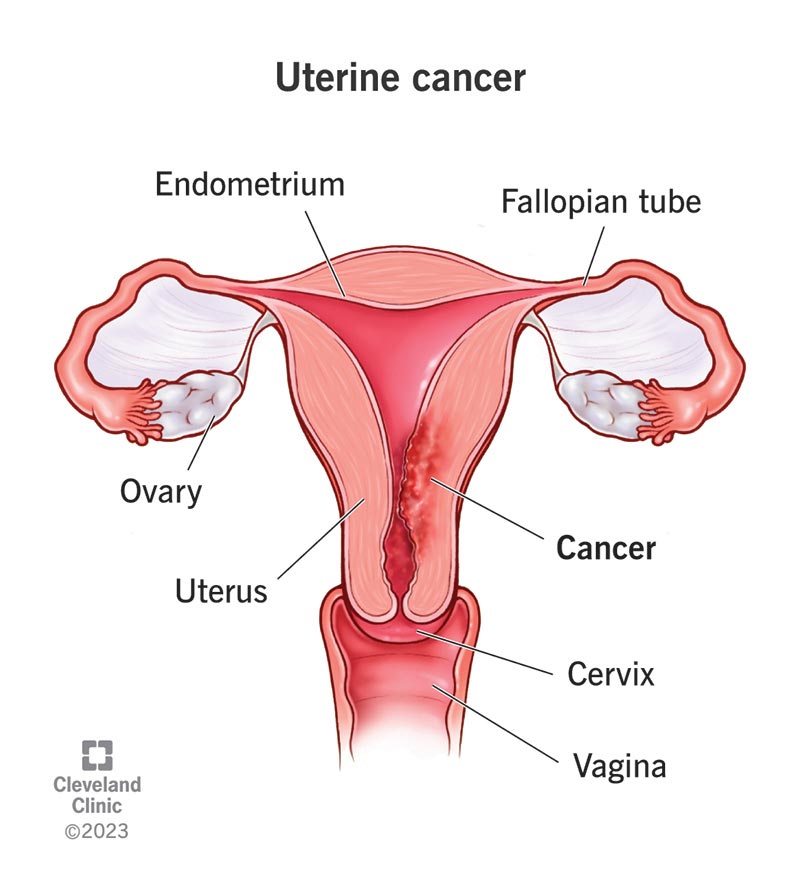An overview of Endometrial Cancer
What is Endometrial cancer?
One type of cancer that starts in the uterus is endometrial cancer. The pear-shaped,hollow pelvic organ known as the uterus is where fetal development takes place.
The layer of cells that makes up the uterine lining (endometrium) is whereendometrial cancer first manifests itself. Uterine cancer is another name forendometrial cancer. Uterine sarcoma is one of the other cancers that can develop inthe uterus, however it is considerably less prevalent than endometrial cancer.

What are the endometrial cancer stages?
Doctors may use the following definitions when staging endometrial cancer:
Stage 0 : Cancerous cells remain where they started, on the surface of theinner lining of the uterus.
Stage 1 : The cancer has spread through the inner lining of the uterus to theendometrium and possibly to the myometrium — the middle layer of the uterine wall.
Stage 2 : The tumor has spread to the cervix.
Stage 3 : The tumor has spread through the uterus to nearby tissue, includingthe vagina or a lymph node.
Stage 4 : The cancer has spread to the bladder or an intestine, and possiblyto other areas, such as the bones, liver, or lungs.
What causes endometrial cancer?
The exact cause of endometrial cancer is unknown. What is known is that somethingtakes place to cause modifications (mutations) in the DNA of the cells that make upthe endometrium, or uterine lining.
The mutation changes normal, healthy cells into aberrant cells. Healthy cells developand proliferate at a specific rate before dying at a specific period. Abnormal cellsdo not undergo a predetermined death; instead, they proliferate and reproduce out ofcontrol. A mass of aberrant cells develops as they accumulate (tumor). Cancerouscells can spread throughout the body by separating from an initial tumor andinvading surrounding tissues (metastasize).
Signs and symptoms of endometrial cancer
Signs and symptoms of endometrial cancer may include:
1. Vaginal bleeding after menopause
2. Bleeding between periods
3. Pelvic pain
Prevention of endometrial cancer
To reduce your risk of endometrial cancer, you may wish to:
Talk to your doctor about the risks of hormone therapy after menopause : Ifyou're considering hormone replacement therapy to help control menopause symptoms,talk to your doctor about the risks and benefits. Unless you've undergone ahysterectomy, replacing estrogen alone after menopause may increase your risk ofendometrial cancer. Taking a combination of estrogen and progestin can reduce thisrisk. Hormone therapy carries other risks, so weigh the benefits and risks with yourdoctor.
Consider taking birth control pills : Using oral contraceptives for at leastone year may reduce endometrial cancer risk. The risk reduction is thought to lastfor several years after you stop taking oral contraceptives. Oral contraceptiveshave side effects, though, so discuss the benefits and risks with your doctor.
Maintain a healthy weight : Obesity increases the risk of endometrial cancer,so work to achieve and maintain a healthy weight. If you need to lose weight,increase your physical activity and reduce the number of calories you eat each day.
How is endometrial cancer diagnosed?
Talk to your healthcare provider if you notice possible signs of uterine cancer. Yourprovider will:
Ask about your symptoms, risk factors and family history.
Perform a physical exam.
Perform a pelvic exam.
Also test such as Imaging tests and lab test will also be done
How is endometrial cancer treated?
Most people with endometrial cancer need surgery. Your particular treatment plandepends on the type of cancer and your overall health. Other treatments you may haveinclude:
Chemotherapy : which uses powerful drugs to destroy cancer cells.
Immunotherapy : which helps your immune system fight cancer.
Targeted therapy : which uses medications to target specific cancer cells tostop them from multiplying.
Radiation therapy : which sends targeted radiation beams to destroy cancercells.
Hormone therapy : which gives hormones or blocks them to treat cancer.
Frequently Asked Questions About endometrial cancer
Uterine cancer can refer to either endometrial cancer,uterine sarcoma or other rare forms of cancer that can arise inyour uterus. But people often treat the terms “endometrialcancer” and “uterine cancer” the same. That’s becauseendometrial cancers are much more common than other cancers thatcan form in your uterus.
There are several risk factors for endometrial cancer.Many of them relate to the balance between estrogen andprogesterone. These risk factors include having obesity, acondition called polycystic ovarian syndrome (PCOS) or takingunopposed estrogen (taking estrogen without taking progesterone,too). A genetic disorder known as Lynch syndrome is another riskfactor unrelated to hormones.
In the United States, endometrial cancer is the mostcommon cancer affecting a DFAB person’s reproductive system.Endometrial cancer mainly develops after menopause. About 3% ofcisgender women receive a diagnosis of uterine cancer at somepoint during their lives.
Many people who have uterine cancer need their ovariesremoved. But removing the ovaries means you will go throughmenopause if you haven’t already. If you’re younger than 45 andpremenopausal, talk to your care team to see if you should keepyour ovaries.